2018 Monaco Grand Prix Historique report
Come rain or shine
Author
- Mattijs Diepraam
Date
- May 19, 2018
Related articles
- Monaco - The full Monte, 2008 GP Monaco Historique report, by Mattijs Diepraam/Frank van de Velde
- Monaco - In Grand Prix heaven, 2014 GP Monaco Historique report, by Mattijs Diepraam
- Monaco - F1 stars celebrate Monaco's F1 history, 2016 GP Monaco Historique report, by Mattijs Diepraam
- Monaco - Sunny, straightforward and chaotic, 2024 GP Monaco Historique report, by Mattijs Diepraam
Who?Michael Lyons, Alex Caffi What?McLaren-Cosworth M26, Ensign-Cosworth N176 Where?Monaco When?XI Monaco Grand Prix Historique (May 13, 2018) |
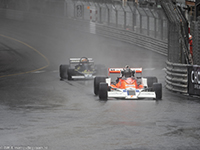 |
Why?
The 11th running of the Monaco Grand Prix Historique gave us more of the same – but also simply more. More cars, more stars, and a new race with a bumper grid. All in two-and-a-half days of lovely spring weather, with four hours filled with rain showers to add even more excitement to a magnificent race day.
Although the programme for this year’s GP Historique followed the usual lines of reviving the history of the Monaco GP there were some important changes. The pre-1961, 1961-1965, 1966-1972 and 1973-1976 F1 grids remained the backbone of the weekend, and the 1952-1957 sportscar race also kept on being a permanent fixture, while the pre-war section was back to being a race instead of a demo.
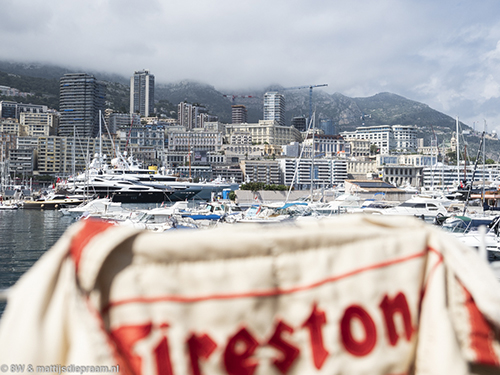
Firestone, Ferrari, Monaco in a glorious Mediterrenean spring sun - can it get any better? (photo 8W)
Gone, however, were the alternating F Junior and F3 races, a sad loss given the fact that both categories are probably closer connected to Monaco’s heritage than the fifties sportscars but in terms of variation one could understand the choice of sticking with one sportscar race among the predominance of single-seaters – apart from the fact that it probably pleased owners that would bring more cars to the event.
Then again, the new 1977-1980 F1 grid more than compensated for the loss of the F Junior/F3 race. With 34 cars and some great driver names, the entry was overflowing with quality – and then the actual race proved a cracker too. It came after a build-up to the event that was dominated by endless discussions about the new roll-hoop regulations issued by the ACM. A small minority of cars was unaffected, leaving most other car owners to fork out the cash for the adaptation.
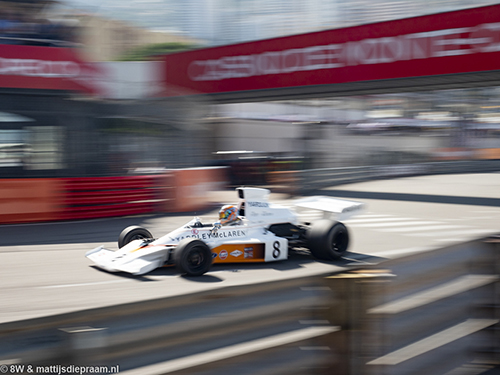
Stuart Hall was very quick in qualifying. Here he rounds Rascasse in the Rofgo McLaren M23. (photo 8W)
But what can you do? Monaco is still the pinnacle for every aspiring historic F1 car owner, and yet more people’s ultimate dream came true in the 11th edition of the event. And in several cases with quite some more cost than the expense of a new roll hoop since especially in the Friday free practice sessions the damage count was quite considerable, many drivers either choking on the special challenge of the principality’s street circuit or simply wanting too much too soon. Behaviour in Saturday qualifying was generally more constrained, even though we still counted a number of red-flag situations.
On Sunday, the pre-war cars were the first to race, and with Michael Gans, Paddins Dowling and Nick Topliss at the sharp end of the grid this looked to be yet another ERA benefit. An ERA did indeed take the spoils but it wasn’t poleman Gans’s example, the American bogging down at the start after which he was swamped by a gaggle of rival cars. It left Dowling alone at the front, and the Irishman duly reeled off the laps to the win while Gans provided the entertainment by making his way back to second place. When he finally reached that Dowling was well out of sight.
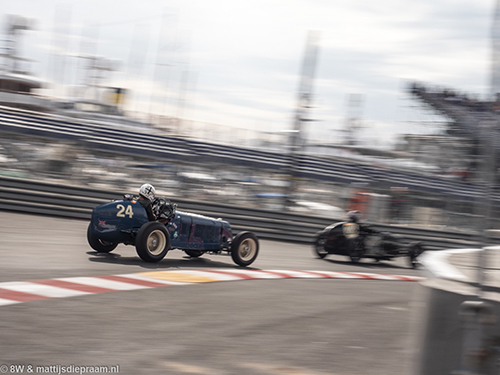
ERAs ruled the roost again in the pre-war race. (photo 8W)
In the closing stages, Nicholas Topliss made it an ERA 1-2-3 but then it was discovered that the chequered flag had been waved one lap too late! Although Topliss sipped the champagne (from a glass, not out of a bottle) on the podium, third place was later handed to Anthony Sinopoli from Switzerland in his Maserati 6CM.
Next up were the 1.5-litre cars from the early sixties, and their race was all about a tense lead battle between Andy Middlehurst’s ex-Jim Clark Lotus-Climax 25 and Joe Colasacco’s ex-Lorenzo Bandini Ferrari 1512. The Italo-American chased Middlehurst for the full 10 laps but could not find a way past. James King in the ex-Dan Gurney Brabham-Climax BT7 was a distant third.
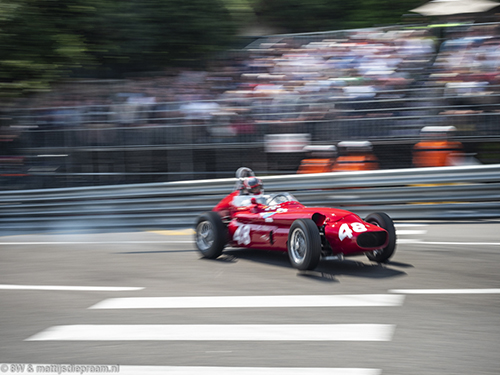
Tony Wood's Tec-Mec was an unstoppable force among the pre-1961 cars. (photo 8W)
The clock was turned back slightly for the third race of the morning, as the pre-1961 F1 cars took to the track. This proved to be a race of swinging fortunes as Julian Bronson’s Scarab-Offenhauser initially jumped poleman Nick Padmore away from the grid. The Lotus 16 driver was soon back into the lead, though, but a few laps later Padmore wasn’t protecting a lead over Bronson anymore, Tony Wood having made his way past into second place in his quick Tec-Mec. Wood in the Maserati 250F derivative then proved unstoppable, also removing Padmore from the lead and running away into the distance. Meanwhile, Bronson lost third place to Joaquin Folch in another Lotus-Climax 16.
In time, the jump to the period of the next race – 1966-1972 – was in several cases less than a decade, showing just how much F1 cars transformed from the late fifties to the early seventies. This first of three races celebrating the coveted 3-litre era of Formula One also showed the first signs of an influx of professional guns-for-hire, Björn Wirdheim joined on the grid by Clivio Piccione in the McLaren M14A and Andy Soucek in the BRM P153. Meanwhile, not just the BRM brought 12-cylinder variety but there was variety in the 12-cylinder cars as well, Manfredo Rossi bringing his Tecno PA123-3 (and qualifying a strong seventh) while Paolo Barilla (Ferrari 312B), Jürgen Boden (Ferrari 312B2), Franco Meiners (Ferrari 312B3-009) and Roald Goethe (Matra MS120C) added even more 12-pot shrill to the DFV’s dark engine notes. The Tecno – complicated though it is – was our clear favourite.
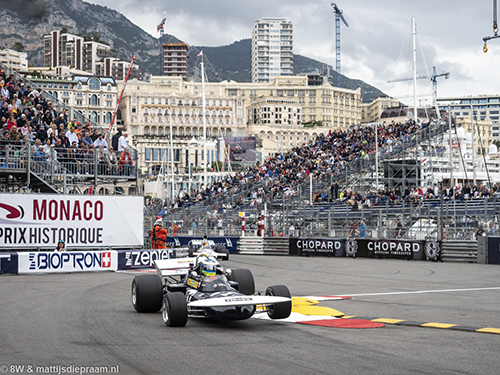
Leading from lights to flag, Björn Wirdheim was the Super Swede of the day in the ex-Ronnie Peterson March 711. (photo 8W)
In the race, Wirdheim in Eje Elgh’s ex-Ronnie Peterson March-Cosworth 711 led from start to finish, beating Stuart Hall’s McLaren M19A, but the eyes were on Michael Lyons (Surtees TS9) who had to make his way forward from ninth on the grid after a miserable qualifying session in which each of his hot laps were interrupted by either yellows or red flags. On his way to a magnificent podium finish, Lyons demonstrated that Monaco is indeed a place where you can overtake – a lesson that others, including Lyons himself, took note of for each of the remaining races.
No-one had told Chris Ward, though. In the run-up to the afternoon’s three races the rain that was forecasted finally came. It turned the sportscar race into arguably the wettest contest of the weekend – which probably made Ward’s job of dominating proceedings in the Cooper-Jaguar T33 even simpler.
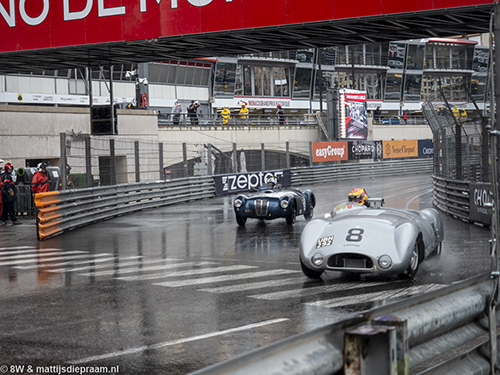
In a class of his own - Chris Ward in the JD Classics Cooper-Jaguar T33. (photo 8W)
The JD Classics driver powered away from the line and that was what everyone else ever saw of him afterwards – apart from the multitude of drivers that were lapped by Ward on his way to an unchallenged victory, of course. Ben Short in the Lister-Maserati was the only one to slightly keep pace with the winner, finishing 34 seconds in arrears. Tony Wood made it to the podium for the second time by taking third in the Lister-Bristol, over a minute down on Ward.
Meanwhile, tension was mounting for the event’s two show-stoppers – the two seventies F1 races. Both would be run on a wet track, and although it dried up pretty quickly during the 1977-1980 race the treacherous conditions played their part in both races. In the 1973-1976 race, Michael Lyons (McLaren M26) produced a great move around the outside of poleman Stuart Hall (McLaren M23) into the chicane, and then the Marlboro car inched away from the Yardley car, which was consequently also passed by 2016 winner Alex Caffi in the Kessel Classic Ensign N176 that was also prepared by Lyons Racing.
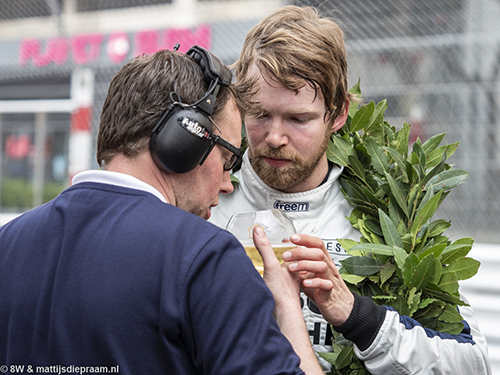
A proper gesture - Michael Lyons letting his faithful mechanic Matt Dobson have a taste of the bubbly. (photo 8W)
The Italian quickly set about pursuing his ‘team mate’ and at times was all over the back of the M26 before losing it at the chicane. Hall having dropped back at the rate of half a second lap was having to defend from Marco Werner in the glorious 1974 version of the Ferrari 312B3 but in the end succeeded in keeping his second second place of the day. Dutchman Nicky Pastorelli, meanwhile, had been closing on Werner in the first half of the race, having stormed up from ninth on the grid, but ended up in the barriers when his Surtees TS19 lost all its brakes.
Would Lyons make it two-out-of-two in the final race? No, and it never looked likely, even though a second place would have been on the cards. No-one would have been able to stop Martin O’Connell though, in the ATS D4 owned by Marc Devis who limped around in the paddock and will hopefully race the car himself later in the year. Despite Lucas, Prince of Darkness, almost stopping O’Connell ahead of Friday practice, the faulty sparkbox that robbed him of a win at Imola playing up again after which the OC Racing mechanics had to quickly improvise with a replacement box, the former British F3 National Class champion first set pole and then ran away with the win on Sunday.
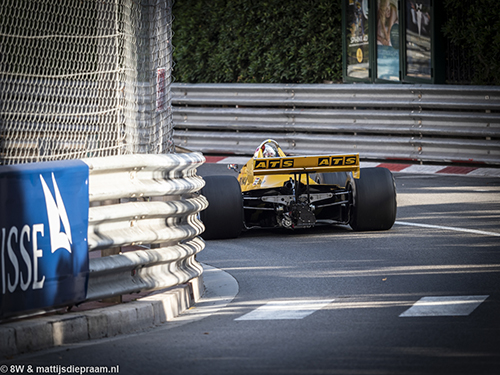
This is what most rivals usually saw of Martin O'Connell's ex-Jan Lammers ATS D4. (photo 8W)
In O’Connell’s wake, Nick Padmore (Shadow DN9) and Michael Lyons (Hesketh 308E) fought over second place, with the former pulling through, and then Lyons lost further places when he was pushed wide into Sainte Devote by Jordan Grogor’s Arrows, who had battled with team mate Nicky Pastorelli before the Dutchman lost it and damaged the nose of his A3. Towards the end, on a rapidly drying track, Grogor pushed Padmore for second but despite his rear wets being completely shot the Shadow driver hung on to his place.
Each of the three days, the lunch break was enlivened with demonstrations. The line-up of stars was pretty impressive: Mika Häkkinen, Jacky Ickx, Eddie Irvine, John Watson and Thierry Boutsen all drove cars that were brought to Monaco anyway, while Williams Heritage brought the ex-Keke Rosberg Williams FW08 for new official driver Karun Chandhok to drive. Porsche was present as well with a Chopard-backed trio of cars led by Jacky Ickx demonstrating the stunning Jules-sponsored Porsche 936-81.
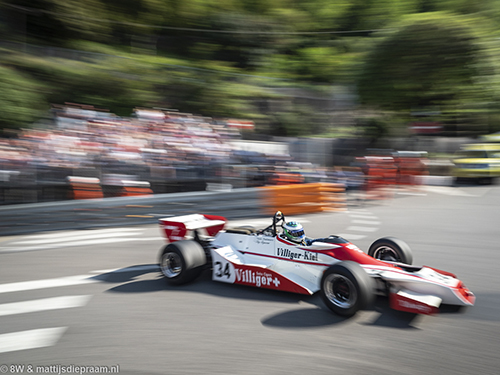
Nick Padmore (Shadow DN9) was O'Connell's closest rival. (photo 8W)
